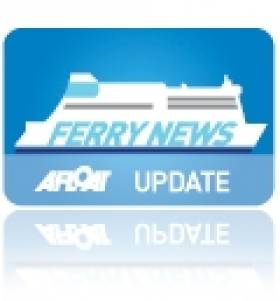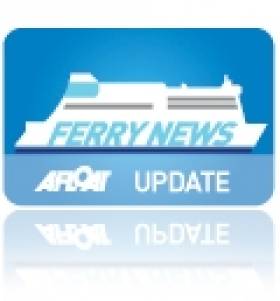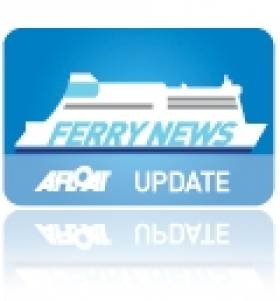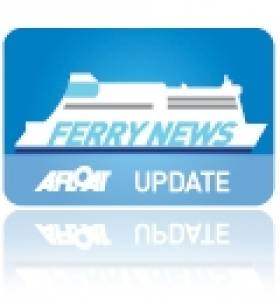Displaying items by tag: Celtic Link Ferries
The Ferry Mobile Way to Book
#FerryMOBILE – Celtic Link Ferries have now made available the option to book a ferry crossing via the mobile phone to those travelling on the operator's service between Rosslare and Cherbourg.
Passengers will be able to research their crossing and or make their reservation via the new mobile booking system.
"Celtic Link Ferries wants to give its passengers as many booking opportunities as possible" said a company spokesperson. "Mobile booking is something that we feel that both our customers and we can benefit from".
Bookings on the French route can be made on smart-phone by visiting www.celticlinkferries.com and from where people can access the responsive website.
The Wexford based ferry operator is one of the first companies in Ireland to use this responsive technology.
UCD Yacht Team Heads off to Paris the Celtic Link Way
#UCDyacht – The UCD Yacht Team are heading off to France tomorrow to compete in the World Cup.The team are travelling with the support of Celtic Link Ferries which operate services on the Rosslare-Cherbourg route.
Last years winners UCD are returning to try and retain their phenomenal accolade.
"Celtic Link Ferries would like to lend its support to the UCD team" said Rory McCall, Marketing Manager of Celtic Link Ferries. "It's a real honour for any person to compete at this level, at any sport. That's why Celtic Link Ferries wanted to be involved".
Celtic Link Ferries would like to extend the very best of luck to the participants who are travelling to France this week. The route operated by ro-pax Celtic Horizon sails thrice weekly round trips.
Special €1 France-Ireland Sailing for St. Patrick’s Day 2014
#Sailfor€1 – As previously reported on Afloat.ie, Celtic Link Ferries are re-launching a special single sailing fare of just €1 on 16 March 2014 between France-Ireland in advance of St. Patrick's Day.
Celtic Link Ferries are offering passengers this unique opportunity to travel with any tourist vehicle (car, van [up to 6.5m long and 2.5m high], motor-home, motorcycle, caravan, minibus or trailer) for as little as €1. The deal also includes everybody that is in the vehicle.
The special sailing offer on the Cherbourg-Rosslare route operated by ro-pax ferry Celtic Horizon, is timed to take advantage of visiting Ireland for St. Patrick's Day on 17 March.
Passenger will be able to their vehicle for some of the best prices ever seen on a ferry service between France and Ireland.
"Its simply an effort to get as many people to come to Ireland for St. Patrick's Day as possible" said a company spokesperson. "We have more direct crossings than anybody else and with that we want as many people to use it as possible".
To book this special deal visit:www.celticlinkferries.com
Celtic Link Ferries See Increase in May Traffic
#FerryNews – Celtic Link Ferries have recorded an increase in both passenger and vehicle traffic for the month of May.
Passengers making southbound Rosslare-Cherbourg sailings have increased by a modest 1.5% for the month compared to the same time last year. In the opposite direction, passenger making sailings to Ireland have increased by more than 14%.
"May figures have been very encouraging" said Rory McCall, Tourist Passenger Manager. "There is a strong desire still for people to go on holidays- our business has grown, simply because we have the best value rates".
The operator which runs ro-pax Celtic Horizon on the thrice weekly round trip service, has seen growth in all types of vehicle traffic that includes not just cars but campervans, motorcycles and coaches.
Celtic Link Ferries to Go Cycling with Giro D’Italia
#CelticGiroDItalia – Celtic Link Ferries Italian flagged ro-pax Celtic Horizon will be carrying the cycling cavalcade for one of the world's greatest cycling events, the prestigious 2014 Giro D'Italia, which takes place next May with an all island staged route, writes Jehan Ashmore.
According to Wexford Chamber of Commerce, the ferry operator which runs between Rosslare-Cherbourg, recently transported a fleet of Volkswagon vehicles to see this year's Giro D'Italia in Naples.
The Giro D'Italia in 2014 will stage its 'Grande Partenza', the Big Start in Belfast and will visit Armagh and also Dublin between 10-12 May.
Hosting three-day event, which will be its 97th edition, will cost in the region of €5,000,000.
It is also estimated the event will generate to the value of €12m and which has the backing of Northern Irish Tourist Board (NITB) and Tourism Ireland.
"Celtic Link Ferries are delighted to be involved with this great event which will be the focus of the entirety of Europe" said Tourist Passenger Manager, Rory McCall.
"We are a perfect fit for something like this" added McCall. "Celtic Link Ferries will give intending passengers the best value means of travelling between Europe and Ireland with a vehicle".
Celtic Horizon which is registered in the Adriatic Sea port of Bari, has a total 2.25 kilometres of vehicle lane metres spread across its decks from where traffic is transported on the thrice weekly operated service.
Afloat.ie adds that Rosslare Europort is no stranger to such sport-related logistics, as the Tour de France made its first and only visit to Ireland in 1998.
On that occasion, ferries transported the cycling cavalcade from the Wexford port and also out of Cork to Roscoff.
#FrenchFerry– As summertime officially starts over the Easter Weekend, perhaps it's also time to set a sailing time of your choice by booking with Celtic Link Ferries, noting the half-price cabin sale!
The operator which runs the ro-pax ferry Celtic Horizon on the thrice weekly Rosslare-Cherbourg route has launched the half price cabin sale and where there's a selection of accommodation ranging from 2-berth, 4-berth and 6-berth cabins plus luxurious suites.
For further information and to make a booking visit: www.celticlinkferries.com
Celtic Link Ferries Bring Visitors for St. Patrick's Gathering
#GatheringVoyage – As previously reported on Afloat.ie Celtic Link Ferries were proud to have transported over 400 passengers on board Celtic Horizon from mainland Europe to Ireland for St. Patrick's Day 2013.
The only ferry company which sails between Ireland and France (Cherbourg-Rosslare) all-year-long gave passengers a unique opportunity last weekend to sail with a vehicle, a cabin and occupants for only €1.
The special priced fare was tied to promote Ireland's year-round Gathering celebration and to encourage people to visit Ireland.
"There was a great atmosphere on board, people delighted with the great offer and getting to come home and see their loved ones" said Tourist Passenger Manager, Rory McCall.
"Celtic Link Ferries did their best to insure that people got to visit Ireland for St. Patrick's Day as comfortably as possible, as cheaply as possible."
McCall added "This will be the first of many offers trying to increase visitors to Ireland and more specifically to Wexford and the rest of the South-East".
"Celtic Link Ferries have been very fortunate to have the support of Rosslare Europort on this offer and look forward with working with them on more special offers for the rest of 2013."
Throughout 2013 Celtic Link Ferries will be offering competitive fares to insure that even more tourists visit Ireland on the thrice-weekly operated Cherbourg-Rosslare route.
The Gathering Looms Ever Closer as Celtic Horizon Heads for St. Patrick’s Festivities
#GatheringVoyage –Passengers today on board Celtic Horizon which is due to make a lunchtime arrival in Rosslare Harbour are taking advantage of a special celebratory 'Gathering' sailing, writes Jehan Ashmore.
As previously reported, Celtic Link Ferries had been promoting a €1 euro motorist fare on this particular crossing which departed Cherbourg yesterday in advance of St. Patrick's Day festivities held across the nation in this year of The Gathering.
In addition to Irish and continental passengers, there are representatives from the tourism sector travelling on this Gathering sailing.
As the Celtic Horizon heads towards the Tuskar Rock Lighthouse, there will no doubt be an on board atmosphere of excitement as the Emerald Isle looms increasingly closer.
Celtic Horizon is the newest and fastest vessel operating on the French-Irish route and among the facilities are the aptly named Tuskar Lounge, Rosslare Bar and Cherbourg Café.
Euro-Celtic Countdown! as Gathering Looms Over the Horizon
#GatheringVoyage- Passengers booked on a Celtic Link Ferries sailing from France one month from today (15 March) in advance of St. Patrick's Day, will be taking advantage of a special €1 euro 'Gathering' fare, writes Jehan Ashmore.
The special offer was an initiative by CLF in this year-long Gathering of events and next month's National Day of festivities.
Celtic Horizon operates three round-trip sailings weekly and among the 27,522 tonnes ro-pax facilities are the Cherbourg Café, Tuskar Lounge and Rosslare Bar. In addition there are a choice of cabin accommodation for the overnight 17-hour crossing between Normandy and Wexford.
Rory McCall, passenger sales manager said "Celtic Link Ferries will ensure that passengers get great value crossings to and from France all year long in 2013. It is only fitting that we give our passengers the best value deal ever between France and Ireland on 15 March".
This month CLF celebrate their eighth year in service, having taken over the route in 2005, following the closure of the service the previous year run by P&O Ferries.
Rosslare Ferries Past and Present Profiles
#FERRY FOCUS – Two Rosslare Europort ferries, past and present are profiled in the latest issue of Ships Monthly. Normandy having served a near decade long career with Irish Ferries and Celtic Horizon as previously reported on Afloat.ie which has only been in service since late 2011 serving Celtic Link Ferries.
The former Normandy, a month ago today was beached at Alang, India to undergo scrapping, following failed plans by Singapore owners to convert her to an offshore accommodation vessel for the energy industry.
She had served several routes throughout Northern Europe since her completion in 1982 as Prinsessan Birgitta for her original owners Sessan Line, before becoming part of Stena Line and at one stage she became 'Sealink's flagship St.Nicholas.
Incidentally during Normandy's career until 2007, her younger sister launched as Kronprinsessan Victoria, now named Stena Europe, was by sheer coincidence sailing out of Rosslare and still remains on Stena Line's route serving Fishguard.
Normandy was the first of the Irish Ferries fleet to change flag, where the Irish tricolour was replaced under the Bahamas flag. This initially led to strike action by UK, French and Irish unions that led to a longer-running hostile dispute during 2005/2006 by Irish seafarers whose jobs were ultimately replaced through outsourcing of lower paid agency crews mostly from Eastern Europe.
Eventually the remaining Irish Ferries vessels, flagship Ulysses, cruiseferry Isle of Inishmore and fast-ferry Jonathan Swift also changed flags, but to Cyprus and with a change of port registry to Limassol.
As for Celtic Horizon she is on a charter contract to Celtic Link Ferries Rosslare-Cherbourg service, the 2006-built ro-pax having served Naples-Sicilian routes for Caronte & Tourist.
The introduction of Celtic Horizon brings increased space and higher standard passenger facilities compared to her predecessor Norman Voyager, which too was delivered from the same Italian shipbuilder Visentini near Venice.
At this time of the year CLF are the only operator providing Irish-French sailings until Irish Ferries re-launch cruiseferry Oscar Wilde sailings for their 2013 season starting in late February, initially to Cherbourg followed in May by additional high-season sailings to Roscoff.






































































